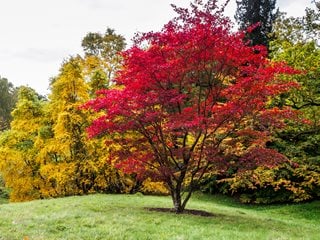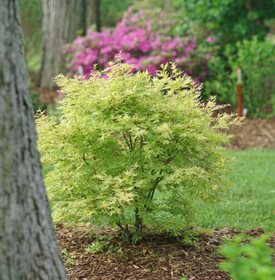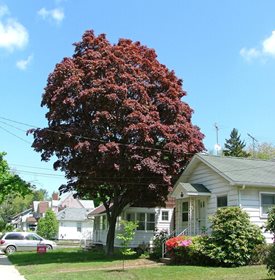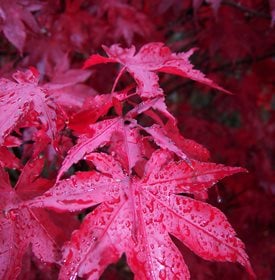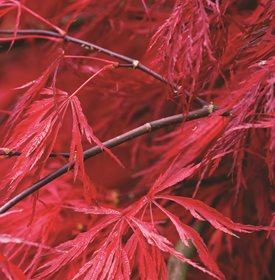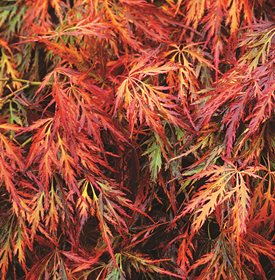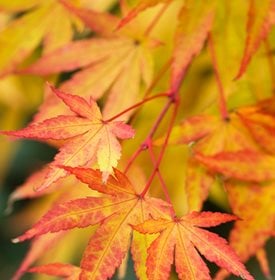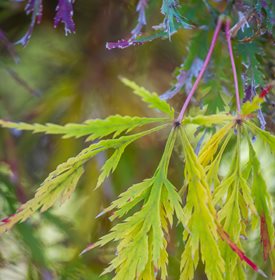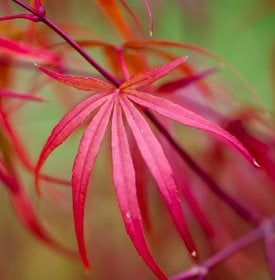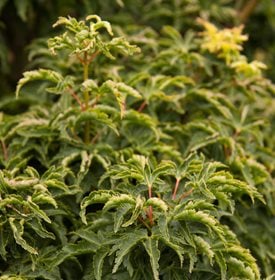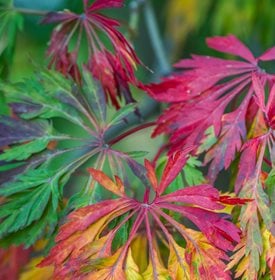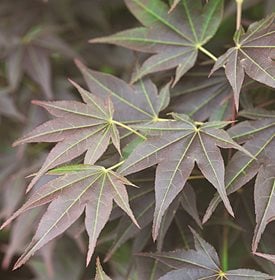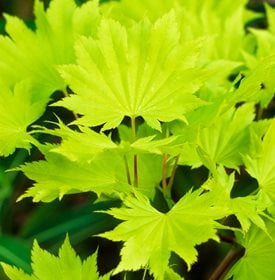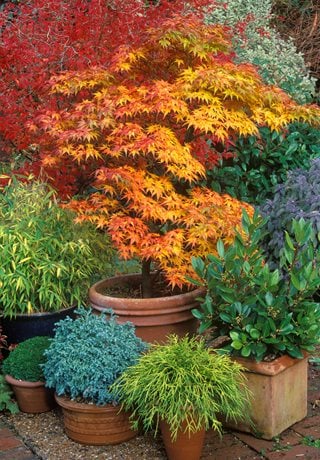Growing and Caring for Japanese Maples
Nothing beats Japanese maples for center of attention drama and vivid fall colorJapanese maple trees can provide a striking focal point, be the perfect plant to set off a large container, or grow into an impressive bonsai specimen. There are hundreds of Japanese maple varieties that come in various sizes with a large assortment of leaf shapes and colors that range from shades of green to orange, red, purple, and variegated.
On this page: The Basics | Planting | Care & Pruning | Pictures | Design Ideas | FAQs
THE BASICS
Zones:
Generally, zones 5-8. Heat is a consideration, especially in the south, not necessarily for the health of the maple but for its effect on leaf color, causing many purple or red-leaved varieties to “go green” in the summer. They typically leaf out early in the season and a late cold snap can cause serious damage even to mature specimens.
Height/Spread:
Varieties from 8 to 30 feet tall and wide.
Exposure:
Providing the right amount of light can be a balancing act. Too much light can damage delicate leaves. Too little light, and some of the more colorful varieties will take on a greenish tone — still attractive, but not the brilliant fall color of reds and purples as would be expected. For best color, most maples need a location with part day's sun or at least high light.
Foliage color:
Famous for their phenomenal fall colors, Japanese maples also present purples, reds, yellows, oranges, and greens as well as variegation throughout the growing season.
Growth rate:
Most Japanese maples grow at a slow to moderate rate of 1 to 2 feet per year. They typically grow fastest when they are young and slow down as they reach maturity. Planting them in a spot where they are happy and caring for them well helps maximize their growth rate. If you want an established look right from the start, you can opt to plant an older, larger maple rather than a young one that may take years to mature. If this isn’t an option, select a cultivar that has a reputation for being a faster-than-average grower, such as Acer palmatum ‘Beni-otake’.
Types:
Japanese maples offer plenty of diversity. Compare the different types of Japanese maples here.
“Mostly slow growing, Japanese maples are the classic small trees for traditional Japanese gardens. They are also well suited to the restricted space of modern suburban gardens, whether planted in the ground or in containers.” —Royal Horticultual Society
PLANTING JAPANESE MAPLES

The compact form of this dwarf variety and its unique arrangement of leaves, which are layered like roof shingles, make Acer palmatum ‘Mikawa Yatsubusa’ an excellent choice for growing in a pot and a top pick of bonsai enthusiasts. Zones 5-8. Photo by: Richard Bloom.
When to plant:
Fall is an excellent time to plant because it allows the roots of your Japanese maple to get established while the rest of the tree is dormant. However, many gardeners also find success planting in the spring. Either way, make sure there is no threat of frost which can damage a newly planted tree.
How to plant:
Dig a hole twice as wide as the root ball but no deeper than the container the plant came in. Gently loosen the roots if they’re tightly bound to encourage outward growth. After placing your tree in the hole, backfill with the original soil, packing it down lightly so the roots are able to breathe. Water your tree thoroughly to settle the soil, then apply a layer of organic mulch or compost around the base, keeping it away from the trunk to prevent rot.
Location:
Japanese maples prefer to be in locations protected from strong winds and spring frosts.
Soil:
Japanese maples are fairly adaptive, but prefer moist, well-drained, slightly acidic soils that contain organic matter. If you live in an area with heavy clay soil, planting them slightly elevated is beneficial; this will help guard against root rot and disease. Chlorosis (yellowing of leaves due to lack of chlorophyll) may occur in high-pH soils.
Container planting:
Many of the smaller varieties are excellent in containers. Japanese maples “self stunt,” meaning their top growth will decrease when their roots are confined. When planting in a container, it is still wise to focus on small to medium varieties or dwarf forms.
“Pots are a great way to try Japanese maples—you can move them around to see what kind of light conditions they like in your garden.” — Steph, Hooked & Rooted
Love trees? Get timely information on trees, shrubs, annuals and perennials, along with planting advice, garden design inspiration, tips, and more in our weekly newsletter.
Jim Putnam of HortTube delves into the art of pruning Japanese maples alongside experts Lynn and Jim Swanson, who maintain the maple collection at JC Raulston Arboretum. Together, they demonstrate a range of pruning techniques while highlighting how strategic pruning can enhance both tree health and visual appeal.
CARE & PRUNING
Water:
Water them well at planting time and regularly thereafter. Although they can endure periodic dry spells once established, you will want to avoid moisture extremes and water regularly during extreme drought. Maples like mulch to protect their roots from heat and cold, as well as reduce the frequency of watering, especially for those in containers. Keep mulch several inches away from the trunk.
Fertilizer:
Low-nitrogen fertilizer is fine in spring (N-15 or lower), but don’t apply after May, as this could impede fall color & winter toughness. It is best to wait to fertilize newly planted Japanese maples until their second growing season.
Pruning:
The key to pruning a Japanese maple is to make strategic cuts that enhance its natural form and improve airflow. Focus on thinning, not cutting back—removing small interior twigs and crossing branches, pruning them at a slight angle above a healthy bud or branch collar. The ideal time to make significant pruning cuts is during the tree’s dormancy period (late winter through early spring), but you can prune at any time to remove dead, damaged, or diseased wood.
Tip: Japanese maples can be limbed up to reveal their sculptural branching and allow easy views of nearby plantings.
Problems, Diseases, Pests:
For the most part, Japanese maples don’t suffer from any serious insect or disease problems. They can be susceptible to stem canker, leaf spots, fusarium, verticillium wilt, botrytis, anthracnose, and root rot. Mites can be troublesome, and other pests may include aphids, scale, borers, and root weevils.
More care information here: Japanese Maple Care
JAPANESE MAPLE PICTURES
In this delightful garden tour, Steph and George of Hooked and Rooted showcase their Japanese maple collection and DIY Japanese-inspired garden. Over two years in the making, their space is a vibrant canvas of extraordinary Japanese maple varieties, with foliage colors ranging from fiery reds to soft yellows and everything in between.
JAPANESE MAPLE DESIGN IDEAS
Japanese maples can stand alone as a single spectacular centerpiece, focal point, or accent, as well as work together to provide a dramatic backdrop. They play well with others, particularly plants with similar light and water needs. Perennials and ground covers planted around them can add additional color to the area as well as provide an area of protection to the trunk from mower and weed-eater injury.
Learn more about how to design a Japanense-style garden.
Companion plants for Japanese maples include:
Ginkgos, dawn redwoods, rhododendrons, azaleas, conifers, sedum, dianthus, coral bells, Japanese forest grass.
FREQUENTLY ASKED QUESTIONS
What are the downsides of Japanese maples?
Japanese maples are stunning trees, but there are a few downsides to consider before planting one. Because most Japanese maples grow slowly, it can take some time before they reach their full potential. They also are sensitive to extreme weather, with leaves prone to scorching in hot climates and delicate branches that can break easily in storms or under heavy snow. In colder climates, they can be vulnerable to frost damage, particularly when temperatures drop suddenly in late spring as the tree begins to leaf out.
Are Japanese maples good to grow in pots?
Many smaller varieties of Japanese maples thrive in pots, making them an excellent choice for patios and balconies. Select a container that is at least twice the size of the root ball and has excellent drainage. Because Japanese maples “self stunt” (meaning their growth will decrease when their roots are confined), they don’t need frequent repotting. However, refreshing the soil every few years and upgrading to a larger pot if the roots become crowded will help maintain their health and vigor.
Are Japanese maple roots invasive?
No, Japanese maples do not have invasive roots. Their root systems are typically shallow and compact, staying close to the soil surface. This makes them generally safe to plant near structures like foundations, walkways, and patios. While their roots are non-aggressive, Japanese maples do best when they aren’t competing with surrounding plants, so be sure to give them plenty of space.
Do Japanese maple lose their leaves in winter?
Yes, Japanese maples are deciduous trees and shed their leaves as winter sets in, leaving the branches bare until fresh foliage emerges in the spring. During the colder months, when the trees are leafless, their graceful branching structure becomes even more pronounced, allowing for a deeper appreciation of their natural elegance.
Why are the leaves on my Japanese maple turning green in summer?
The leaves of certain Japanese maple cultivars naturally shift in color throughout the seasons, beginning with brighter hues in spring and gradually turning green as summer progresses. Sun exposure also plays a significant role. Some red-foliaged varieties may lose their vibrancy if they don’t receive enough sunlight. Nutrient deficiencies, particularly a lack of phosphorus, can also affect leaf pigmentation and contribute to a greener appearance.
Which Japanese maple variety is best for full sun?
A number of Japanese maple varieties handle full sun well, particularly those with green or deep red foliage that resists scorching. A few options to consider include ‘Bloodgood’, Samurai Sword™, and ‘Sango Kaku’. Even when growing sun-tolerant varieties, it's best to provide some protection from intense afternoon sun, particularly in hot climates.
RELATED:
Trees with Colorful Fall Foliage
Zen Garden Design
Maple Garden in Ohio
